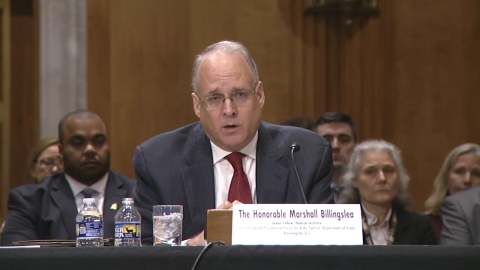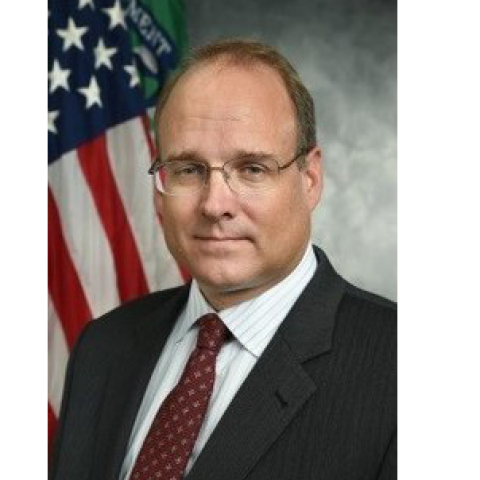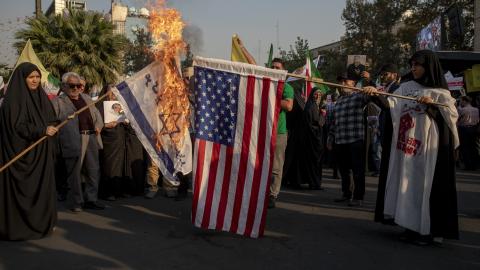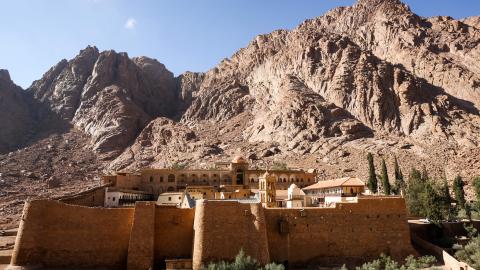(ANALYSIS) St. Catherine's, the Christian world's oldest continuing monastery, drew international attention earlier this year because of concern that the Egyptian government might take over its sacred property. A complex May 28 Egyptian regional court decision threatened to take title of most of its land.
The monastery is in the news again, and for unhappy reasons connected to the court decision. Under pressure from Greek Orthodox leaders internationally, the monastery's head, Archbishop Damianos, announced that he would resign as of Sept 12. Meanwhile, on Sept. 8, the Synod of the Patriarchate of Jerusalem unanimously resolved that Damianos be already deposed.
These changes roil the already complex negotiations over St. Catherine's status. This great monastery lies at the foot of Mount Sinai, where God gave the Ten Commandments to Moses. It is reputed to contain the burning bush from which God spoke to Moses. Its ancient documents are unrivaled. The Codex Sinaiticus, a fourth-century manuscript, contains most of the Greek Old Testament and is the oldest complete copy of the New Testament.
That it has survived for over 1,000 years in a remote area connecting continents and traversed by marauding armies is itself something of a miracle. Also, it is reported to contain a covenant of protection granted by Islam’s Prophet Mohammad in the year 623 and reaffirmed by Ottoman Sultan Selim I in the 16th century. Behind its fortified walls, it has survived in one of the world's roughest neighborhoods.
Despite its historic status, the court's convoluted May 28 decision means that the Egyptian government could assert property rights over most of the monastery grounds. The Egyptian government downplays this concern and stresses "the importance of preserving the close and fraternal relations that bind the two countries and peoples and not compromising them.”
Subsequent events are complex and divisive. Since the monastery is Greek Orthodox, it has worked together with Greek government and much of the Orthodox world to shape its response to the court's decision and to the Egyptian government itself.
Meanwhile, there has been increasing unrest among its monks, especially concerning the role of aged Archbishop Damianos, who has led the monastery for 52 years. This reached a head when a majority of the monks announced that they had removed Damianos as St. Catherine's head. In turn, the archbishop threatened to excommunicate the rebellious monks.
The monks then sent a July 30 delegation and letter to Theophilos III, Greek Orthodox Patriarch of Jerusalem, requesting his intervention to reconcile their divisions. Their letter stated: the "General Assembly of the Sinai Brotherhood today ... unanimously decided to depose Archbishop Damianos of Sinai... from his position as Abbot and Archbishop.”
Theophilos responded positively to this initiative and dispatched three senior clergy to the monastery to help resolve the matter. However well-intentioned, this initiative ventured into the minefield of Orthodox church jurisdiction and hence further increased tensions.
While the Jerusalem Patriarchate has ecclesial jurisdiction over much of the Middle East, it remains unclear that this includes St. Catherine's. The monastery's own website states that it is "unsubdued, immune, untrampled by anyone, and totally free from all and everyone. Furthermore, it is Autocephalous.” This Autocephaly would give it the same canonical status as, say, the Russian or Greek Orthodox churches, and make it a self-governing church, albeit the smallest, within the Eastern Orthodox family. To complicate matters, the website also acknowledges an undefined “broader spiritual relationship with the Patriarch of Jerusalem.”
However, in a subsequent letter to Damianos, Theophilos asserted his jurisdiction over the monastery. His letter stated that "the Patriarchate of Jerusalem bears the spiritual and canonical jurisdiction over the Patriarchal and Stavropegial Monastery of Sinai.”
Archbishop Damianos responded very negatively, stressing the ongoing “titanic effort began to save the monastery and secure its future” from possible Egyptian court action and lamented that. … Yet, at this very moment, when hope has returned and efforts are finally yielding results, the words of Dionysios Solomos prove true once again: “Discord, that wretched one, holds a scepter. She smiles upon each man and says, ‘Take it for yourself.’”
Other critics suggested that the Patriarchate was “acting with the primary goal of consolidating its role as the central interlocutor in all decisions concerning the future of St. Catherine’s Monastery.” In the face of these conflicts, messages were sent from both Athens and the Ecumenical Patriarch stressing their weakening support for Damianos' stance. In return, the 91-year-old Archbishop announced that he had begun the process to choose his successor.
This process was short-circuited since on Sept. 8, the Patriarchate unanimously resolved to depose Damianos. These disputes have weakened St. Catherine's response to the legal challenges from the Egyptian courts, just when there are indications that a resolution might with reach.
On Sept. 7, Greek Prime Minister Kyriakos Mitsotakis stated that Greece and Egypt were “close to signing an agreement” on the monastery's legal status. However, such an agreement would require the agreement of the monastery's head but now, with Damianos' deposition, this position is now vacant.
While there has been conflict between churches over this key monastery, governments may have made greater progress. As Mitsotakis suggests, Egypt and Greece are close to an agreement.
These governments have a great interest in resolving the matter amicably. They are allies in the eastern Mediterranean against Turkey and Libya in disputes over undersea cables and, most important, oil and gas rights, and so want urgently to maintain good relations. Such secular gods may help resolve beloved St. Catherine's protection despite ongoing disputes within the churches themselves.



















